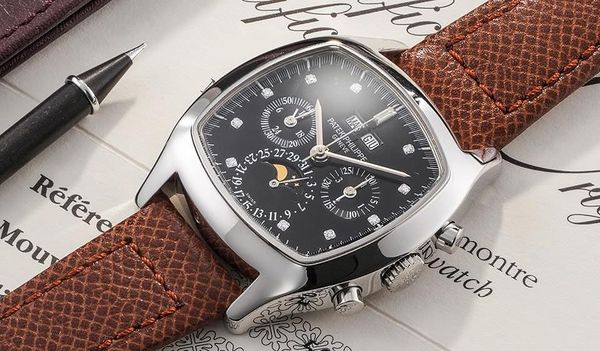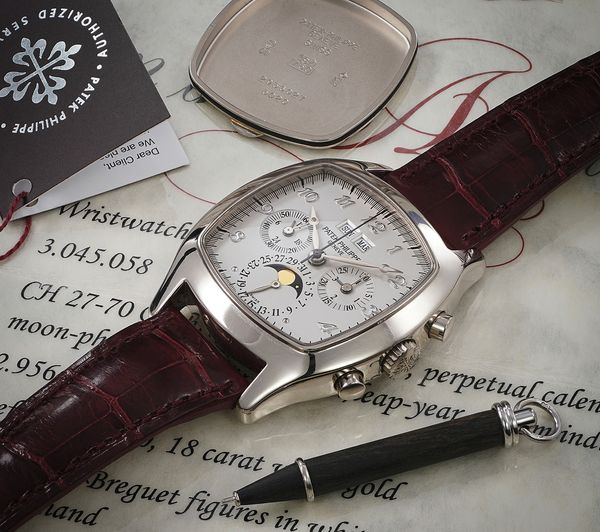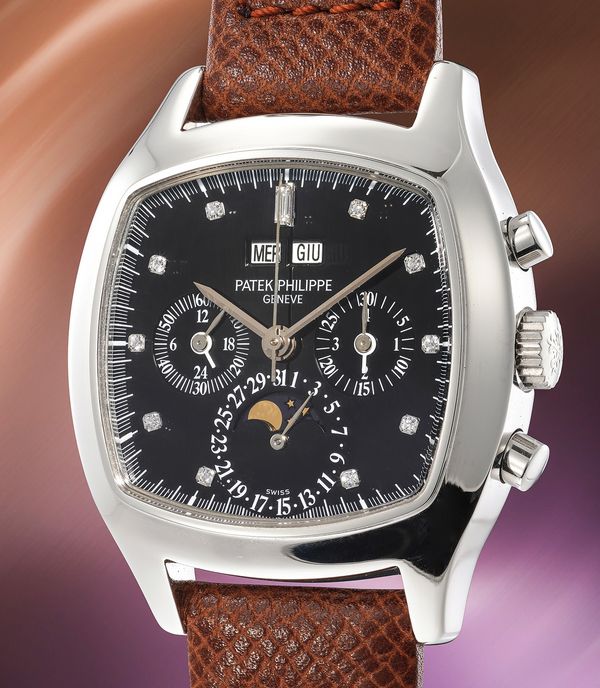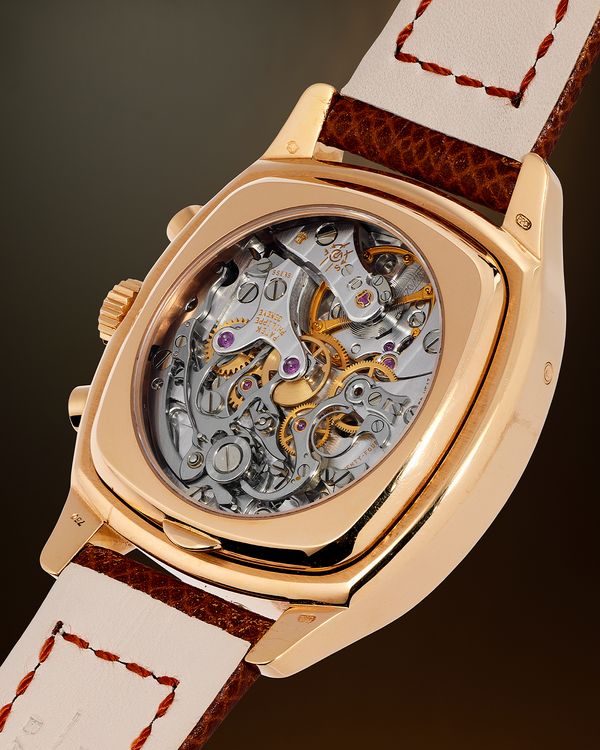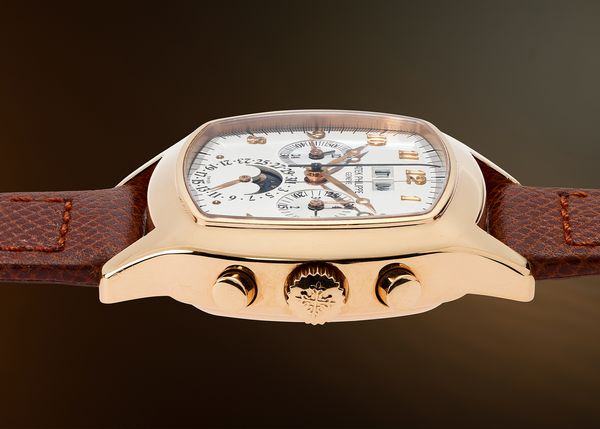Our first live auction of 2024, the PHILLIPS Geneva Watch Auction: XIX, takes place on May 11 and 12, at the Hotel President, at Quai Wilson 47 in central Geneva. The auction includes more than 215 of the world's finest watches – and though we are loath to boast, we truly think it's one of the best catalogs we've ever put together. We'll be highlighting a number of the most interesting lots and stories featured in the sale over the next month, including a lovely example of a platinum Patek Philippe ref. 5020.
– Logan Baker
The lineage of perpetual calendar chronographs at Patek Philippe seems like it should be fairly straightforward. You probably know the core references by heart: 1518, 2499, 3970, 5970, 5270. They’re as iconic and recognizable a series of digits as you’ll ever see in watchmaking. Patek Philippe has spent the past 82 years with at least one of those references in production, with each following another in succession.
However, there was a brief spell in the late 1990s and early 2000s where Patek offered its flagship perpetual calendar chronograph in two distinct versions with entirely different reference numbers. The ref. 3970 is the model that most collectors and watch lovers will know, but its little-known and rarely discussed sibling is the TV-shaped ref. 5020, an alternative take on the perpetual calendar chronograph that was practically identical to the 3970 outside of its tonneau-style, cushion case profile.
It was the first and only perpetual calendar chronograph from Patek Philippe to not have a round case.
It’s well-known that the ref. 3970 was in production at Patek Philippe for almost two decades, between 1986 and 2004, helping lead the family-run Swiss firm into the new century. The ref. 5020, meanwhile, was basically a blip in the 3970’s lifespan. It was introduced almost a decade after the 3970, in 1994/95, and closed its production run in 2002, two years before the 3970 bid a final adieu to collectors, immediately replaced by the next-generation ref. 5970.
Released under Philippe Stern’s leadership at Patek Philippe, the ref. 5020 was wholly unexpected by the company’s clientele – and it failed to develop any sort of traction on the market. Low demand from retailers and clients resulted in low production figures.
It’s believed that Patek only brought somewhere between 200 to 250 examples of the ref. 5020 to market, in all configurations and case metals, during the model’s short eight-year lifespan. That production figure would place the ref. 5020 closer in quantifiable rarity to the ref. 1518 than its closest sibling, the ref. 3970, which is believed to have reached a total of approximately 3,600 examples over 18 years.
It’s easily the rarest of Patek Philippe’s four modern perpetual calendar chronograph references: 3970, 5020, 5970, and 5270.
The movement inside the 5020 was identical to what was found inside the 3970, the manual-wind Lemania-based caliber 27-70 Q. It comes equipped with perpetual calendar, chronograph, and moon-phase mechanisms, alongside a free-sprung Gyromax balance wheel, a Y-shaped chronograph bridge, a polished cap over the column wheel, and high-grade decoration worthy of the Geneva Seal, all visible through an additional exhibition caseback.
The cushion-shaped, TV-style cases measured 37mm × 45mm and were made for Patek Philippe by Atelier Réunis, a workshop that historically made some of the brand’s most important case designs. The tonneau case design offered a much larger profile on the wrist than the 3970. In fact, I’ve heard from some collectors who believe the 3970 – as classic as it is – is simply too small (36mm diameter) for all the complications it has. Those collectors believe the 5020 and 5970 (40mm) hit the nail on the head for the perfect size for a Patek perpetual calendar chronograph, while the 5270 (41mm) might have pushed things a bit too far. The look of the 5020 was also clearly inspired by early Patek Philippe wristwatches from around the 1920s era.
The 5020 was offered in four total precious metals: 18k yellow gold, 18k pink gold, 18k white gold, and platinum. Approximately 200 examples were made combined in all the gold metals (yellow, pink, white gold), and another 20-plus pieces were created in platinum. There are also a number of unique pieces in all four metals that are known to the market and have appeared at auction over the years. Interestingly, the gold versions of the 5020 were delivered with both a solid and an exhibition caseback, while for unknown reasons, the platinum examples were only delivered with solid casebacks. Patek eventually also came out with the ref. 5021, which was identical to the 5020 outside the addition of diamond setting on the bezels.
Dials of the 5020 are typically defined by the eye-catching use of applied Breguet hands and numerals, a choice that reinforces the quasi-vintage design language, though there are some unique pieces that utilize different handsets and hour markers. The larger case design compared to the 3970 also allowed for plenty of room for the complications, with ample negative space, offering improved legibility and what was clearly a more modern take on the dial architecture of a perpetual calendar chronograph. The applied Breguet numerals offer a nice sense of depth for the rest of the dial.
The 5020 shares the same dial layout as all the other Patek Philippe perpetual calendar chronographs. The day-of-week and month displays are placed in twin-line apertures underneath 12 o’clock, balanced nicely with the bosom-style moon-phase display located inside the small date sub-dial above six o’clock. Stacked registers can naturally then be found at the three and nine o’clock positions; the three o’clock sub-dial houses the leap-year indicator.
The moon-phase display on all the gold examples combines a yellow moon and stars with a blue-sky background, while the platinum models (with black or blue dials) utilize a silver-tone moon and stars and a black background; platinum models with salmon or silver/white dials also feature the yellow/blue configuration.
The most common 5020 configuration includes applied Breguet numerals on an opaline silver-white dial paired with a leather strap. Every case metal was produced in this format, but every case metal also has slight deviations.
Based on data I gathered for all 5020 results from the top five auction houses for watches, we know of at least six 5020 examples that came with a matching five-link brick-style bracelet (one pink gold, three yellow gold, two platinum); nine examples with diamond hour markers instead of Breguet numerals (one yellow gold, eight platinum); 10 with black dials (one pink gold, one yellow gold, eight platinum); plus a number of other unique or extremely rare configurations, such as a yellow gold case with a brown dial (one known), a white gold case with a luminous grey dial with feuille hands (one known), a platinum case with a blue dial and matching platinum bracelet (one known), and a platinum case with a salmon dial (two known).
A total of 68 examples, in all configurations, have appeared at the top five international watch auction houses over the past two decades. Pink gold has been the most common (22 examples), followed by yellow (19), platinum (15), and white gold (12). Despite the slight increase in appearances for the platinum 5020 over the white gold, it’s safe to assume that the platinum series had a smaller production; it carries a higher value than all gold variations. It’s also likely fair to assume the pink and yellow gold examples are more common than the white gold 5020.
Out of all four case metals, the platinum series has seen the most variations. We know of at least six different platinum 5020 configurations, including black dials with Breguet numerals (two known), black dials with diamond hour markers (six known), silver/white dials with Breguet numerals (four known), salmon dial with diamond hour markers (two known, one each on bracelet and strap), and a unique example featuring a blue dial with Breguet numerals and bracelet.
On the topic of unique or possibly unique 5020 examples, you simply must start with the bespoke pieces made by Patek at the request of the individual known as “MSO.” A well-known media executive and prodigious Patek Philippe collector, MSO is confirmed to have custom-ordered at least three different 5020 examples after the model’s official discontinuation. All three came in different case metals but featured a few signature qualities known to custom Pateks owned by MSO, including luminous dot hour markers used everywhere except the Breguet-style 12 o’clock numeral, lume-filled feuille hands, a tachymeter scale, and the MSO signature hidden above six o’clock. The three known MSO 5020s include a pink gold example with a black dial and matching bracelet (the only known pink gold 5020 on bracelet), a white gold example with a soft grey dial on leather strap, and a platinum example with a beautiful blue dial on matching bracelet.
Other potentially unique examples include a yellow gold example paired with a brown dial, Breguet numerals, and strap; and a yellow gold example with a black dial, diamond hour markers, and a matching bracelet. Phillips Geneva sold the only known platinum 5020 with a salmon dial, diamond hour markers, lume-filled feuille hands, and a factory-confirmed matching platinum five-link bracelet in November 2020, for a remarkable CHF 585,900.
The 5020 is a rare watch – truly. But it’s still remarkably undervalued compared to its complicated siblings at Patek Philippe. We see a handful of examples every year. If we move on from the unique pieces and narrow our scope down to the past five years of results for the 5020 at auction, from the beginning of 2018 until today, you can unearth some interesting data. Unlike the historic data, the yellow gold and the platinum 5020s are tied for the most appearances at auction since the start of 2018, with six each. The pink gold 5020 is right behind them, however, with four, and will tie the 5020J and 5020P total by the end of November, with one example of the 5020R appearing in all our fall 2023 live auctions, including the Geneva Watch Auction: XVIII, the Hong Kong Watch Auction: XVII, and the New York Watch Auction: NINE. The white-gold 5020G, meanwhile, has seen only three examples come to auction in the past five years.
From a value perspective, the 5020J had the lowest average result, at USD $159,292, followed by the 5020R at USD $195,059, the 5020G at USD $230,284, and the 5020P at a combined total of USD $418,030. The biggest percentage increase in performance from earliest to most recent appearance at auction (over the past five years) was the 5020J, jumping 44.5 percent in value, while the 5020P saw the largest decrease in value, dropping between 30.6 percent (for the black dial with diamond hour markers) to 35.3 percent (for the white/silver dial with Arabic numerals). The single most valuable configuration for the 5020 at auction over the past five years was the black-dial, platinum 5020P with diamond hour markers on the dial. Three examples sold at an average price of $388,399. Another interesting detail is that two-thirds of the 21 examples of the 5020 to sell at auction since the start of 2018 were sold at Hong Kong-based auctions (14 in Hong Kong, four in Geneva, and three in New York).
If you compare recent 3970 results with the 5020, you’ll notice some major discrepancies. There’s only a slight difference between our averaged-out 5070J total of USD $159,292 and the result of USD $127,000 for a 3970J at Phillips New York this summer. But there’s a much more significant difference between the 3970G and the 5020G. The most recent Phillips result for the former landed at approximately USD $82,241 in today’s dollars, compared to the latter’s adjusted five-year average result of USD $230,284. Regardless, pricing for both the 5020 and 3970 remain far below their ancestors, the 1518 and 2499 – and with the remarkably low production figures for the 5020 (believed to be under 250 units), the 5020 offers a very compelling argument as the Patek Philippe perpetual calendar chronograph that offers the most value for money.
We’ll never know why, exactly, the 5020 was born. Why did Patek Philippe feel the need to expand their complicated line-up in such an unconventional direction? Some rumors I’ve seen hint that the numerous economic crises that struck many Asian countries and markets in the mid-1990s caused a noticeable decline in interest for the 3970. Perhaps the 5020’s unexpected birth can be credited to Patek’s desire to freshen up the flagship complication in a new look and feel, to appeal to a new generation of collectors.
Whatever the reason is, we know the 5020 was a mishap of a release for Patek Philippe. What’s interesting, however, is we can uncover threads of the 5020’s TV-shaped identity in a number of other, more recent releases. The 5951 combines a perpetual calendar with a split-seconds chronograph in a cushion-shaped case, while the tonneau-shaped 5950 and 5940 focus on one or the other; the former has only a split-seconds chronograph, the latter has only a perpetual calendar mechanism.
However, Patek Philippe has yet to revisit the precise 5020 formula of a conventional chronograph paired with a perpetual calendar inside a TV-shaped case.
That's right, there's nothing in Patek Philippe history quite like the 5020.
You can learn more, place a bid, and view the entire Geneva Watch Auction: XIX catalog right here.
About Phillips In Association With Bacs & Russo
The team of specialists at PHILLIPS Watches is dedicated to an uncompromised approach to quality, transparency, and client service. Phillips in Association with Bacs & Russo holds the world record for the most successful watch auction, with its Geneva Watch Auction: XIV having realized $74.5 million in 2021. Over the course of 2021 and 2022, the company sold 100% of the watches offered, a first in the industry, resulting in the highest annual total in history across all the auction houses at $227 million.
About Logan Baker
Logan has spent the past decade reporting on every aspect of the watch business. He joined Phillips in Association with Bacs & Russo at the start of 2023 as the department's Senior Editorial Manager. He splits his time between New York and Geneva.
Recommended Reading
Specialists' Picks: The New York Watch Auction: NINE
A Complete History Of The Legendary Rolex Triple Calendar Moonphase Ref. 6062
Compact Dimensions And Complicated Watches: A Look At Patek Philippe Under Philippe Stern
